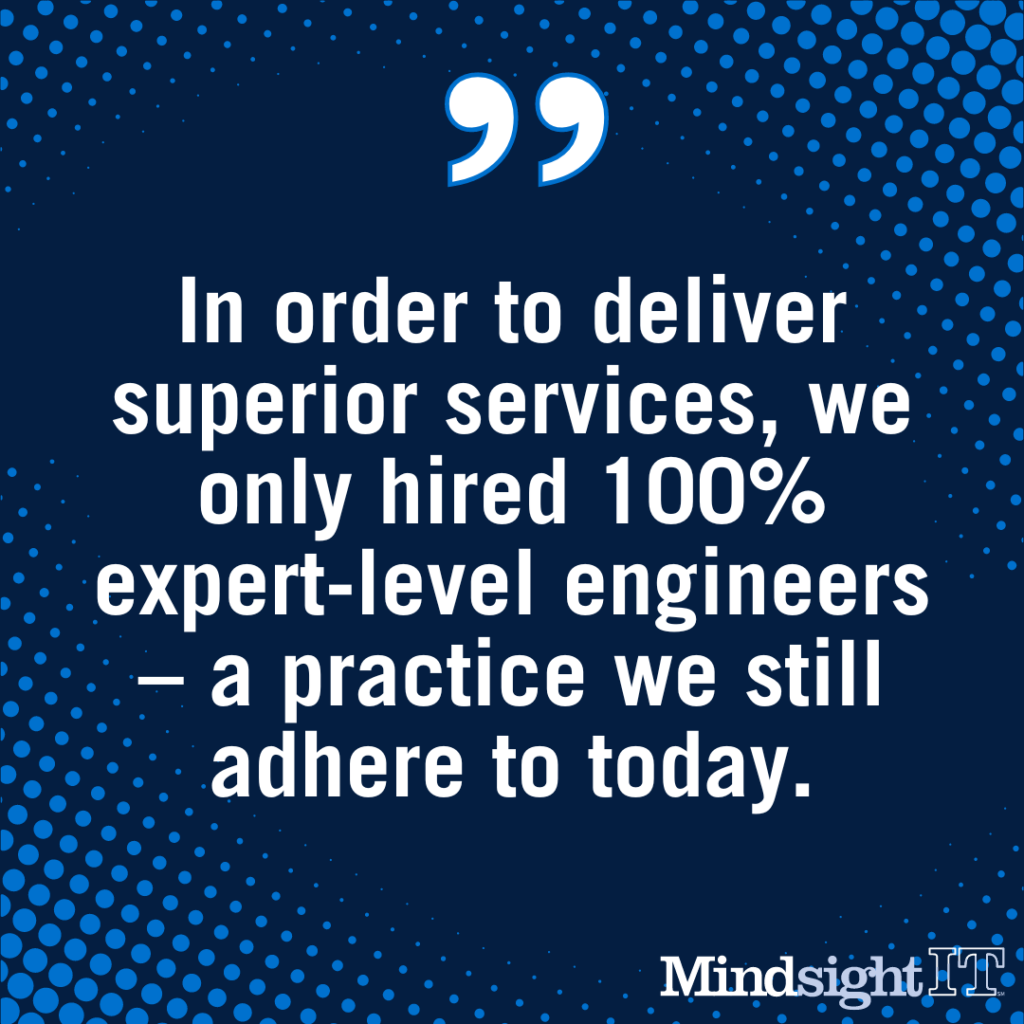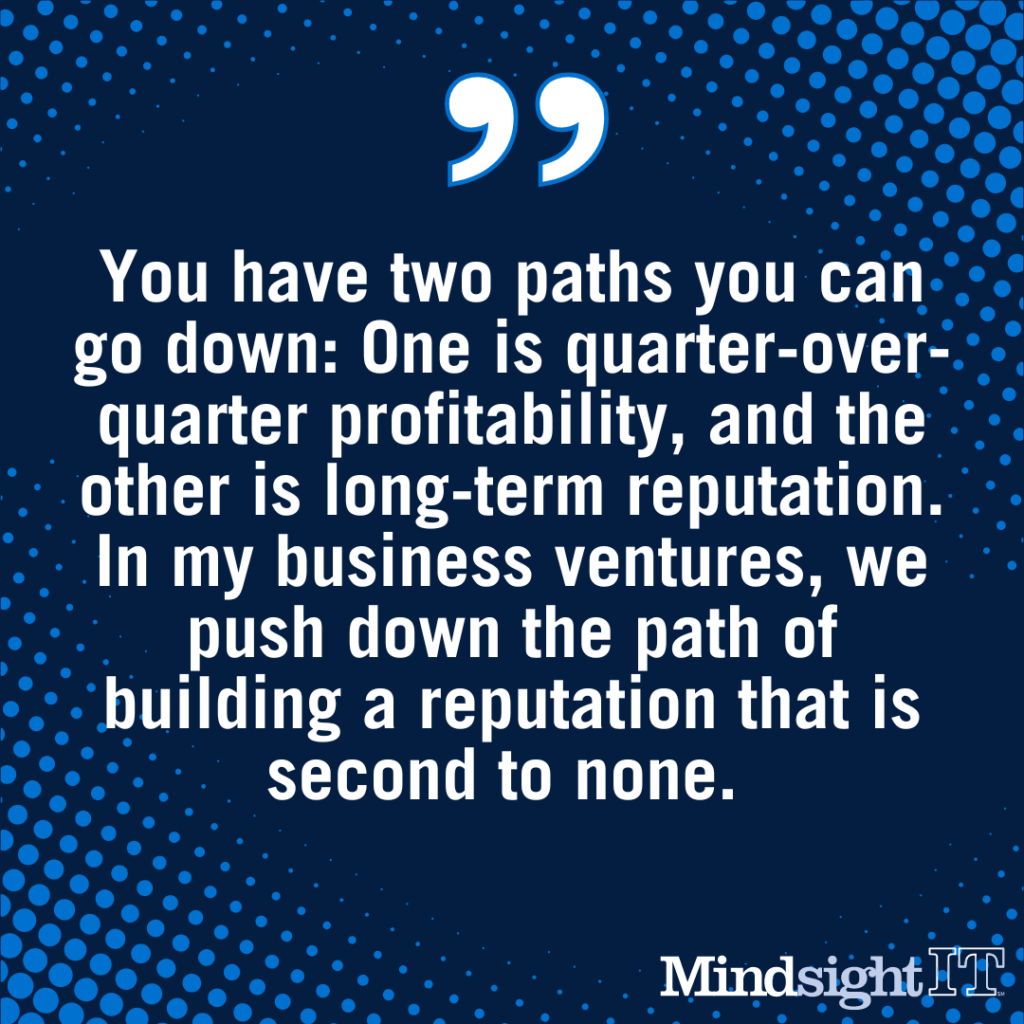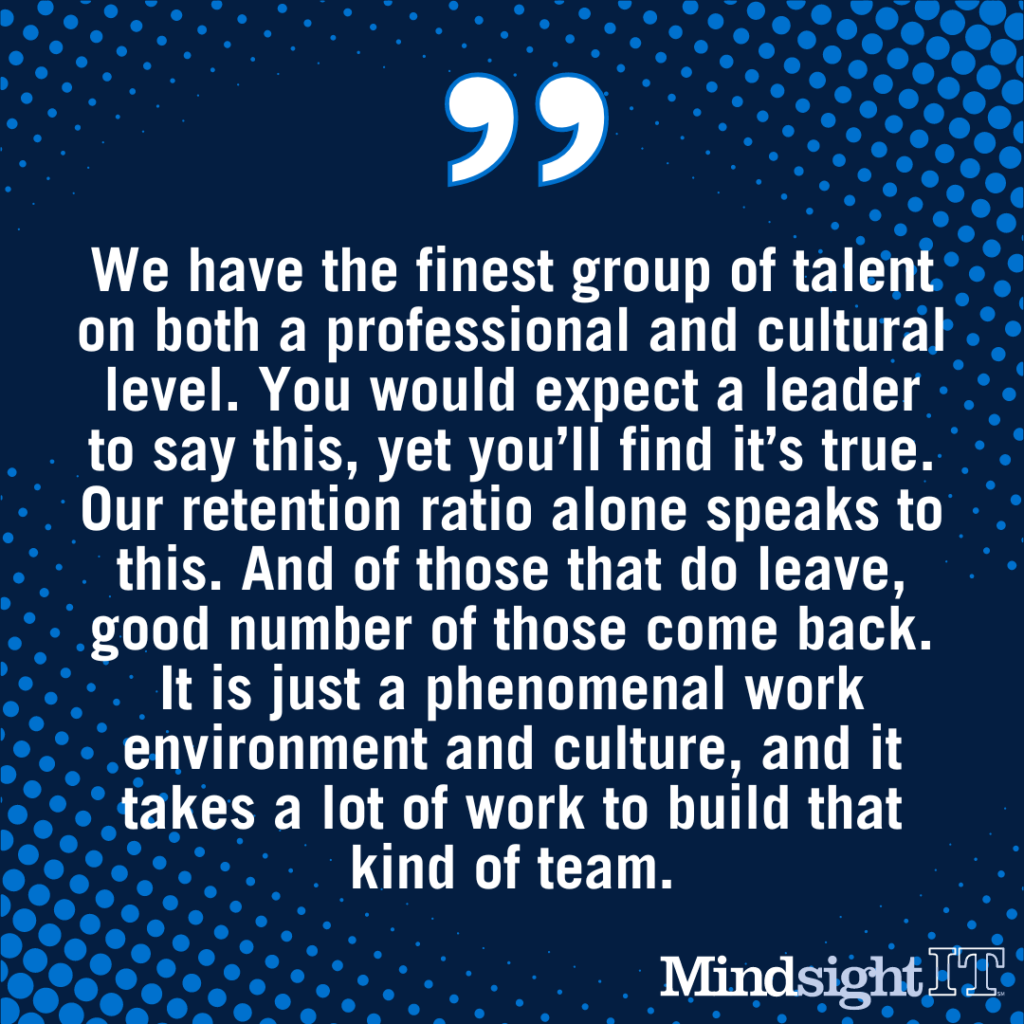May 30, 2023
After two decades in IT, three of those years as Chief Technology Officer for Amundsen Davis law firm in Chicago, valued Mindsight partner Christine Pedersen has learned a great deal about effectively aligning IT priorities to business objectives. She spoke recently about her professional journey, influential mentors, and the rise of women in IT.
What sparked your interest in IT?
My first full time job was with an international law firm in the 1990s. The firm was heavily paper-based given the nature of the business – client intake forms, faxes, traditional mail. We needed to move to an automated way of processing information and that really got me interested in how technology might simplify things for the firm. Eventually we went from all-paper to a searchable database, and by the end of the 1990s we were processing more and more information electronically. I was supervising the teams who were managing this data inflow and outflow. The opportunities to project manage while we were transitioning to online further piqued my interest in a technology role. I was working with tech folks, vendors, staff and various teams, which gave me a very broad spectrum of responsibilities and insights.
How did you rise to your current CTO position?
I came to Amundsen Davis in 2019 as a senior manager in technology. I had been in technology and leadership roles for 18 years prior to joining Amundsen Davis, working directly with CIOs and CFOs so I was well aware of CIO responsibilities and what it took to manage a team in a professional services firm. When the CTO role became available at Amundsen Davis, I applied, went through the rigorous interview process, and was selected. The biggest challenge in transitioning to the role was managing an entire team that was responsible for meeting the needs of the business and doing it in a very cost-effective manner. For instance, we need to manage and measure risk. Since I’ve taken this role, security threats have advanced significantly and I need to be sure that our 400+ users and our applications remain secure.
In addition to security, what are your other main business and IT objectives?
Supporting the attorneys and the professional staff — making sure that we are secure, and have the modern, functional tools that enable everyone to be productive and provide the best service to our clients. Delivering superior service is one of my teams’ primary objectives.
What kind of leader are you in terms of approach and philosophy?
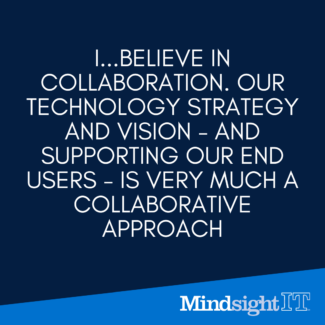 I am results-driven. What are our KPIs? Are we solving problems? Are things stable? I expect to see how many requests we have in any given week, how many are resolved, and how many issues we can’t resolve or need more information to resolve. I also believe in collaboration. Our technology strategy and vision – and supporting our end users – is very much a collaborative approach — with my project manager and my managers across the team. We have multiple infrastructure and application engineers; when we’re discussing solutions, I want our team members to be open and have a voice. I want my direct managers who manage the larger teams to have buy-in so making those decisions is always collaborative. We have to ensure everyone’s on board and that we’re all in agreement as best as we can be before moving forward.
I am results-driven. What are our KPIs? Are we solving problems? Are things stable? I expect to see how many requests we have in any given week, how many are resolved, and how many issues we can’t resolve or need more information to resolve. I also believe in collaboration. Our technology strategy and vision – and supporting our end users – is very much a collaborative approach — with my project manager and my managers across the team. We have multiple infrastructure and application engineers; when we’re discussing solutions, I want our team members to be open and have a voice. I want my direct managers who manage the larger teams to have buy-in so making those decisions is always collaborative. We have to ensure everyone’s on board and that we’re all in agreement as best as we can be before moving forward.
Who were your mentors?
I’ve had several female mentors that played a significant role in my life. The first is my mother; she was/is an amazing woman and a single mom for most of my childhood. She showed up every day and was present and that’s what I do for my family and my team. I have an open-door policy and every day I make time to be available. There was also a woman named Judy Herreweyers, my first full-time manager in the early ’90s when we were digitizing everything. She was not technical at all, but she really supported and embraced my learning. And she always said, “Don’t take anything personally.” That was a good lesson in my early 20s. She also taught me the importance of being adaptable. Things are changing fast, and you need to move with them. Don’t try to hold back. Another wonderful woman at my previous firm, Nancy Trattner, was in technology. She led many key projects and was involved primarily with custom coding. And this is back in the ’90s and early 2000s. She really showed me how she made it work with a family while having a full-time and very important role in the organization. We have remained friends and get together socially on occasion. And finally, was Christine Lagarde, now president of the European Central Bank. For many years she was an attorney at my previous firm and at a very tumultuous time was elected as the first female managing CEO. She was really an inspiration to me, and it was wonderful at a young age to see someone who was female continue to advance in a predominantly male dominated industry.
What are some of your biggest challenges as CIO, and how do you deal with failure?
What really drew me to and kept me in technology was the variety. There’s always something new. It certainly is easier than it was back in the old days when we kept everything on prem. But the mentorship and the learning of really dealing with people and not taking things personally has served me well in all areas of life. It’s rarely personal. In my prior role, there would be many times we encountered a crossroads and we could agree to disagree, and we would do it respectfully, then move forward.
My failures have generally been around timelines when something unexpected happens. Sometimes there’s a hard cost associated with that delay. However, the bigger part of failure is the uncertainty. You make a decision, you’re all going in the same direction, and then you have to pivot. That’s when we’re more concerned about failures and uncertainty. There have been a couple of times I’ve had to do a big 180 and just go in a completely different direction due to a vendor, or a security challenge. I look to learn something every day and I don’t dwell on my failures.
Which accomplishments are you most proud of — from your current role or past roles?
I’m always going to strive for better, and I’m not a quitter. My biggest accomplishments are some of the technology projects I’ve managed and the dynamic teams that made them a success. It wasn’t always easy to get stakeholder buy-in, especially in circumstances where people had very strong opinions about an initiative and I had to persuade them to look at the situation differently. There have been multiple projects where I’ve succeeded at persuading people and getting that buy-in. Also, many of my team members have gone on to do bigger and better things and I’m happy that I was a part of their journey and professional development. One is a chief innovation officer, and another has gone on to lead a department that manages risk and conflict intake. Especially if I hired that person initially, to see them grow — that’s a huge personal accomplishment.
What are your interactions like with senior leadership? Do you sit in strategic planning meetings? If so, how do you communicate the organizational value of IT?
The leadership at Amundsen Davis is inspiring. They really do open the door to all of their C-level teams. The administrative teams support firm operations and support our service groups. We sit at the table with the executive committee. I report to the COO who reports in to the managing partner and we interact regularly. I meet with the C-level leadership under the COO every other week to discuss pressing items across the departments and areas of business challenge where technology can add value. It’s valuable receive their input. We meet twice a year with a larger executive committee where I present on major initiatives and things we’ve accomplished. Cybersecurity is always a main topic and I share what my team has done to keep the firm secure from threats that just continue to increase in volume across our platforms and applications. They welcome the updates and are appreciative to learn how proactive the team is. I’m looking forward to collaborating with other teams and finding innovative solutions that will enable our growth. I have not had that opportunity because of the workload inherited when I took on the CTO role, but that is on the horizon in the next 12 to 18 months.
The tech industry remains overwhelmingly male-dominated. Is gender still a limiting factor in some ways?
I was fortunate that my previous firm was very large and had many women in technology leadership roles – as well as in other areas of leadership. I was initially hired into a non-technology role by a female, and then when I moved into technology, I also had a female manager. Both were very successful in their roles. As I advanced, I actually only had one male direct manager in 20 years, and that was toward the end of my time at the previous firm. All of the others in my 10 different roles were women.
When I was looking to join Amundsen Davis in 2019 and saw that thirty-five percent of our attorneys are women, I felt confident the new role would be a good fit. In the tech industry, I think the percentage of female to male professionals is improving. Close friends that I’ve worked with throughout my career are all involved in technology, and they are really helping to push women in tech — they hire women, they are interacting with more women. One of my closest female friends owns a technology consulting firm and she’s very focused on diversity in general. So every area of diversity is improving, it’s not just focused on women.
What advice do you have for girls and women looking to get into IT, or for those aspiring to C-suite roles — CIO, CFO, COO, etc?
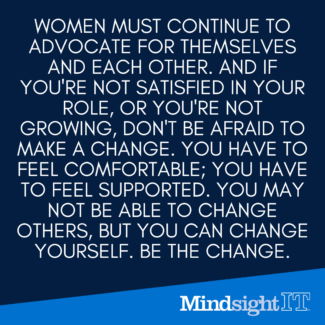 I have several nieces who are now finishing up college and entering the workforce, and we talk about many careers in technology or related to technology. One of them participated in the Girls Who Code program. She’s now working in analytics and data science and loving it. I encourage technology for everyone, not just girls. Every organization and almost every professional job uses technology in some way. There’s constant innovation and change, so careers will always be available. When I hire, I look at the skill set, the personality, and how the person would fit and complement the team. I’ve been very fortunate to have worked with several really wonderful women. I’ve mentored a few and would always tell them, “Don’t be afraid, don’t second-guess yourself. Put your question out there, make sure it’s thoughtful and respectful. And if you get turned down, that’s fine. Move forward in another way, apply a different lens. Maybe your approach wasn’t as well thought out as it should have been, or it didn’t get the right buy-in.” Women must continue to advocate for themselves and each other. And if you’re not satisfied in your role, or you’re not growing, don’t be afraid to make a change. You have to feel comfortable; you have to feel supported. You may not be able to change others, but you can change yourself. Be the change.
I have several nieces who are now finishing up college and entering the workforce, and we talk about many careers in technology or related to technology. One of them participated in the Girls Who Code program. She’s now working in analytics and data science and loving it. I encourage technology for everyone, not just girls. Every organization and almost every professional job uses technology in some way. There’s constant innovation and change, so careers will always be available. When I hire, I look at the skill set, the personality, and how the person would fit and complement the team. I’ve been very fortunate to have worked with several really wonderful women. I’ve mentored a few and would always tell them, “Don’t be afraid, don’t second-guess yourself. Put your question out there, make sure it’s thoughtful and respectful. And if you get turned down, that’s fine. Move forward in another way, apply a different lens. Maybe your approach wasn’t as well thought out as it should have been, or it didn’t get the right buy-in.” Women must continue to advocate for themselves and each other. And if you’re not satisfied in your role, or you’re not growing, don’t be afraid to make a change. You have to feel comfortable; you have to feel supported. You may not be able to change others, but you can change yourself. Be the change.
What’s something non-work-related that most people don’t know about you?
I’m mildly addicted to an online word puzzles game called WordScapes. I’m on a team and we have tournaments every weekend, Friday through Sunday. I can sometimes spend hours playing the game on my phone on a rainy day, just losing myself in a word puzzle. I’m also a very creative person. When my kids were young, I handmade 3D-type invitations for every party. Also, I’m an interior designer at heart.
What’s one thing you know now that you wish you’d known as a young woman rising in the ranks?
Learning the value of self-reflection. Back in my 20s, it was always about moving forward and trying different things. I didn’t spend much time looking back and saying, was I helpful as well as consultative, did I encourage others enough — especially when something went wrong. In the last 10 years, I’ve done regular self-reflection, sometimes even daily if I’ve had a really challenging day or week. It’s helped me figure out, How am I going to do this better next time?
About Mindsight
Mindsight is industry recognized for delivering secure IT solutions and thought leadership that address your infrastructure and communications needs. Our engineers are expert level only – and they’re known as the most respected and valued engineering team based in Chicago, serving emerging to enterprise organizations around the globe. That’s why clients trust Mindsight as an extension of their IT team.
Visit us at http://www.gomindsight.com.


